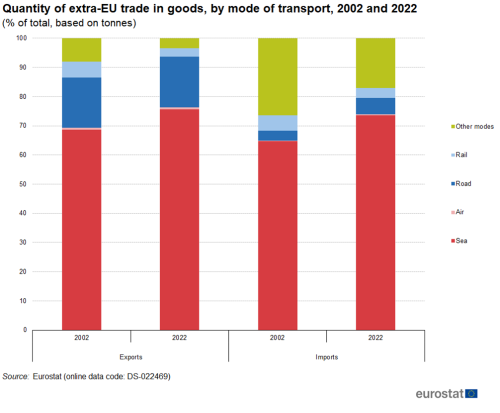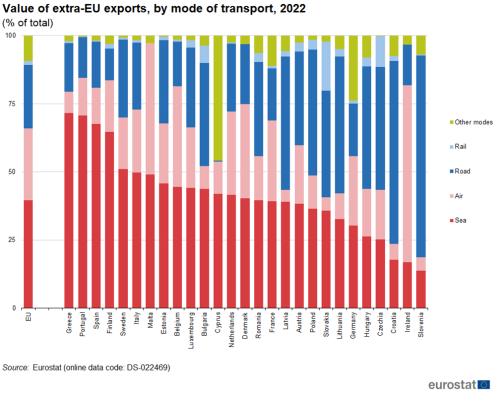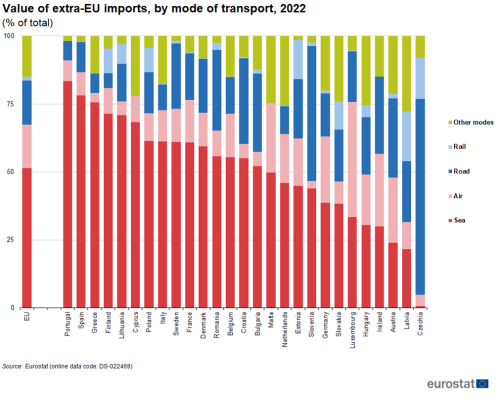International trade in goods by mode of transport
Trade by mode of transport in value and quantity
There are a wide range of factors that may influence the decisions of enterprises as to which type of transport they use when trading goods, among others: the destination country, the size and weight of the goods being transported, the speed of delivery (for example, perishable goods), rules and regulations (for example, concerning the transport of animals), environmental or security considerations (for example, dangerous goods). Measured in value, in 2022, sea transportation accounted for 46 % of goods traded between the EU and the rest of the world, measured in volume the share was 74 %. Figure 1 shows the structure of extra-EU trade by mode of transport, with sea transportation accounting for 39.6 % of the value of goods exported from the EU and 51.5 % of goods imported into the EU in 2022.
Air transportation accounted for 26.3 % of the EU's exports and 15.9 % of its imports. Road transportation accounted for 23.4 % of the EU's exports and 16.1 % of its imports. Other modes of transport which include pipelines accounted for 9.3 % of exports and 14.9 % of imports.
Rail transportation (1.4 % exports, 1.6 % imports) had only a minor share. The share of imported goods that were transported by sea rose by 8.1 percentage points (pp)[1] during the period under consideration, while there was a decrease in the use of sea transportation for EU exports, their share falling by 2.6 pp. The share of goods transported by road decreased by 2.2 pp for imports and increased 2.9 pp for exports.
Imports by air transportation (-3.0 pp) and other modes of transport (-2.9 pp) both decreased.
 Figure 1: Value of extra-EU trade in goods, by mode of transport, 2002 and 2022(% of total)Source: Eurostat - Comext DS-022469[2]
Figure 1: Value of extra-EU trade in goods, by mode of transport, 2002 and 2022(% of total)Source: Eurostat - Comext DS-022469[2]
Figure 2 shows a similar analysis but in quantity rather than value terms.
It shows that the relative importance of sea transportation was even greater, accounting for 75.6 % of EU exports and 73.7 % of EU imports in 2022. There was also confirmation that the relative share of sea transportation in the total quantity of goods transported to and from the EU rose between 2002 and 2022. It is interesting to note that in quantity terms (based on tonnes), air transportation accounted for just 0.8 % of the EU's exported goods and 0.2 % of its imported goods in 2022; the difference when compared with the shares of air transportation in value terms gives an indication as to the high unit value of goods transported by air.
 Figure 2: Quantity of extra-EU trade in goods, by mode of transport, 2002 and 2022(% of total, based on tonnes)Source: Eurostat - Comext DS-022469[3]
Figure 2: Quantity of extra-EU trade in goods, by mode of transport, 2002 and 2022(% of total, based on tonnes)Source: Eurostat - Comext DS-022469[3]
Variations by EU Member State
Among the EU Member States, Greece, Portugal and Spain recorded the highest shares of their extra-EU exports in 2020 carried by sea As noted above, geographical location may play an important role in determining the relative importance of different modes of transport that are used for transporting goods.
For example, Ireland, Cyprus and Malta are all islands separated from mainland Europe, while countries such as Greece, Portugal and Finland are found around the periphery of the EU, a relatively long distance away from some of Europe's main transport hubs. That said, infrastructure developments have improved connections (in the form of new roads and rail links, tunnels, bridges and pipelines) so that there are nowadays far greater possibilities for onward transport to these countries. Figure 3 presents information on the preferred mode of transport for each of the EU Member States in 2022; note again that the statistics presented concern only extra-EU trade.
The highest proportions of extra-EU exports (in value terms) carried by sea were recorded in Greece (71.6 %), Portugal (70.6 %) and Spain (67.7 %); sea was the principal mode of transport for extra-EU exports in a majority (18) of the Member States. Air transportation was the preferred mode of transport for exports from Ireland (65.0 %) in 2022. By contrast, road transportation had the highest share in several of the eastern Member States (Latvia, Poland, Slovakia, Lithuania, Hungary, Czechia, Croatia and Slovenia) that joined the EU in 2004 or more recently, reflecting their geographical location close to a number of neighbouring countries on the Eurasian landmass.
 Figure 3: Value of extra-EU exports, by mode of transport, 2022(% of total)Source: Eurostat - Comext DS-022469[4]
Figure 3: Value of extra-EU exports, by mode of transport, 2022(% of total)Source: Eurostat - Comext DS-022469[4]
As regards goods imported into the EU (as shown in Figure 4), the relative importance of sea transportation was generally even greater. Indeed, sea was the preferred mode of transport for imports in 22 of the EU Member States in 2022. It accounted for more than 75 % of the total value of trade with countries outside the EU in Portugal (83.5 %), Greece (78.1 %) and Spain (75.6 %).
Road transportation was the preferred mode of transport in Slovenia, Austria, Latvia and Czechia and air transportation in Luxembourg.
 Figure 4: Value of extra-EU imports, by mode of transport, 2022(% of total)Source: Eurostat - Comext DS-022469[5]
Figure 4: Value of extra-EU imports, by mode of transport, 2022(% of total)Source: Eurostat - Comext DS-022469[5]
References
- ^ Glossary:Percentage point (ec.europa.eu)
- ^ Comext DS-022469 (ec.europa.eu)
- ^ Comext DS-022469 (ec.europa.eu)
- ^ Comext DS-022469 (ec.europa.eu)
- ^ Comext DS-022469 (ec.europa.eu)